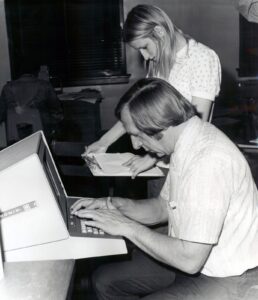
with student Donna Newman, 1974-1975
Computing on campus began in Fall 1967 with the creation of the Administrative Computer Center. Due to an increased workload and growing demands on the facility, the Administrative Computer Center was reorganized in 1973 and split into two units — the Academic Computer Center and the Administrative Computer Center. Campus administrators continued to use the existing campus computer, while faculty and students connected to the Triangle Universities Computation Center (TUCC) in Raleigh through a medium speed batch terminal connection.
The newly-formed Academic Computer Center opened its doors on October 1, 1973, with its main office in the Graham Building and an additional two locations in the Petty Science Building. The center was placed under the direction of Dr. Joseph R. Denk, along with five permanent staff positions and eight student assistants. The primary function of the center was to support instructional computing. The center held workshops to help faculty and staff become acquainted with the computer and what it could offer. These workshops provided introductions about the facility on services, policies, file and data management, and basics of computing.
After a year, Dr. Joseph R. Denk resigned to become director of the New Jersey Educational Computer Network. The center was place under an Acting Director, Dr. Terry G. Seaks of the Economic Department. On August 1, 1976, Dr. Theodore Hildebrandt was named director of the center. Along with its full time staff, the center also hired student workers. The students were divided into two types: Student Consultants and Student Attendants. The Student Consultants were hired to provide help with programming and debugging for the student and faculty users. The Student Attendants dealt with the operation of the medium-speed HETRA terminal, providing courier service, and other housekeeping duties.
In 1978, the administrative office of the Academic Computer Center was relocated from the Graham Building to the Petty Science Building and then again in 1979 to the new Bryan Building. The new facilities provided for a separate room for reference materials used by Student Consultants to aid in consultations. Dr. Hildebrandt led a campaign to gather funds to acquire their own computer for the center and succeeded in purchasing one in 1980. The new academic computer, the DEC VAX-11/780, allowed for the center to not only have their own computer and not have to share with the Administrative Computer Center, but enabled them to no longer have to connect with TUCC. The new computer resulted in the building of thirteen new interactive terminals and allowed access in three other buildings on campus.
After ten years of leading the center, Dr. Hildebrandt resigned in 1986 and returned to teaching and research in the Department of Mathematics. Dr. Gary Grandon became the new director and saw great expansion. By 1988, the center was responsible for maintaining and providing user service for twelve student labs on campus, five faculty self-service labs on campus, and training for faculty and staff in the McNutt Building. Workshops and seminars were given on such topics as introduction to word processing and spreadsheets, hard disk organization and maintenance, desktop publishing, and presentation graphics for faculty.
With the need for a campus-wide computer network, the Administrative Computer Center and Academic Computer Center merged back into a single operation in 1990 becoming Computing and Information Systems. The new unit was placed under the control of Richard L. Moore as an interim director. He was replaced a year later by James Clotfelter. By this time, the campus had successfully completed installation of a broadband cable system. Also, a growing number of faculty offices had computers from which academics could access all of the computing and communications services offered across the campus.